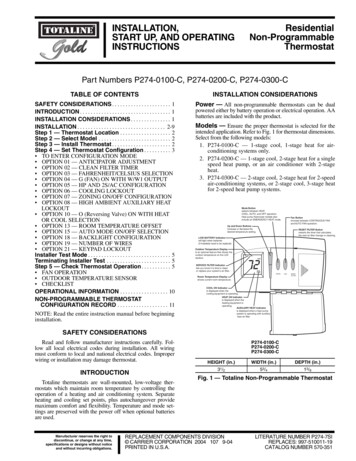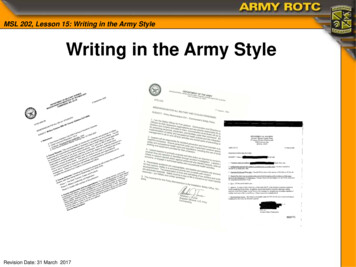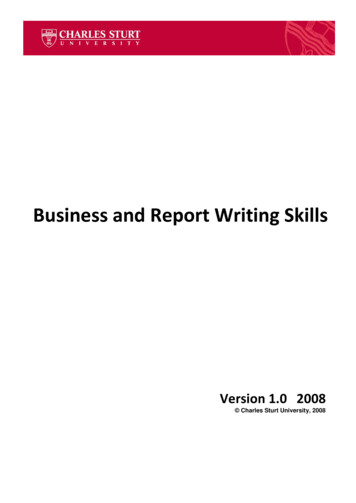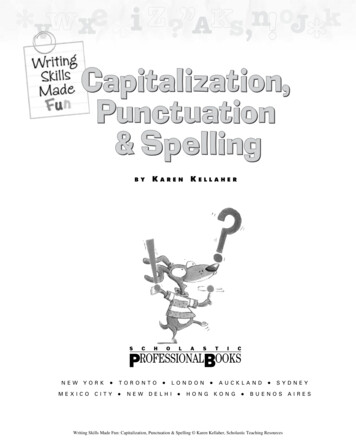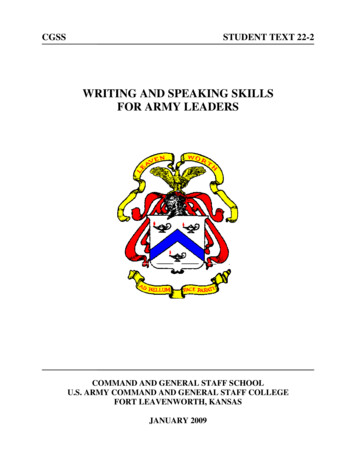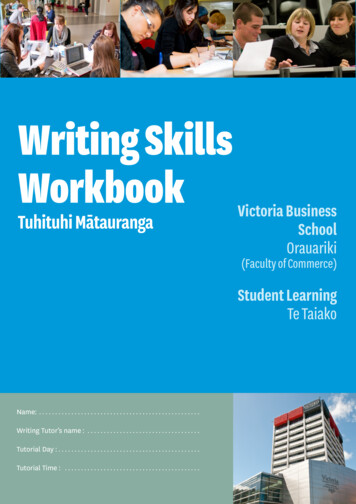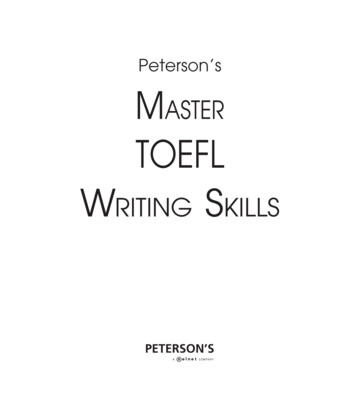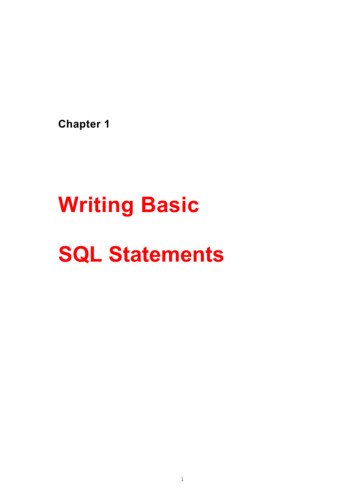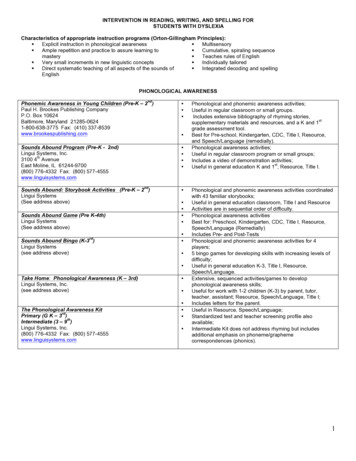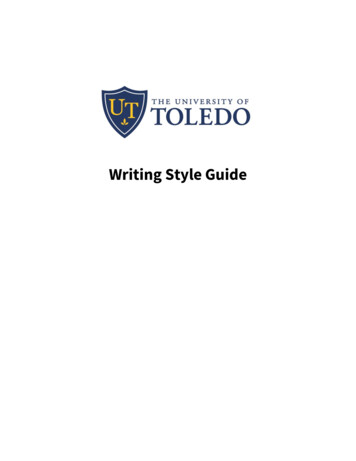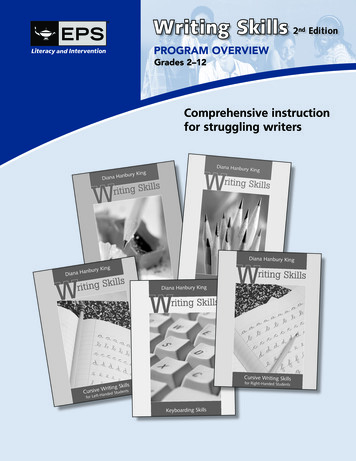
Transcription
Writing Skills 2ndEditionPROGRAM OVERVIEWGrades 2–12Comprehensive instructionfor struggling writers
What is Writing Skills?Writing Skills, by Diana Hanbury King, is a comprehensive writing program for beginning, struggling, at-risk,or reluctant writers. For these writers, this structured program provides an essential foundation in thinkingand writing skills. For proficient and advanced writers, it offers strategies, techniques, and opportunities toapply them.Writing Skills provides special instruction in spelling, handwriting, and keyboarding, and addressesimportant skills that many writing curricula take for granted. The series comprises: Four student books (A, 1, 2 and 3) providing detailed, step-by-step instruction in grammar, composition,mechanics, usage, and editing A comprehensive Teacher’s Handbook with strategies for direct instruction Two cursive handwriting student books specially designed for both right- and left-handed students A keyboarding student book, utilizing a multisensory and kinesthetic approach that is especiallyeffective for students with learning differencesWriting Skills Grade Levels Writing Skills Book A — Grades 2–4 Writing Skills Book 1 — Grades 5–6 Writing Skills Book 2 — Grades 7–8Go to epsbooks.com/WritingSkills to find: Research paper Sample lessons Writing Skills Book 3 — Grades 9–12 Cursive Writing Skills for Right-Handed Students — ungraded Cursive Writing Skills for Left-Handed Students — ungraded Keyboarding Skills — ungraded Teacher's Handbook — ungradedResearch-Based Writing InstructionResearch shows that explicit instruction benefits both struggling and proficient writers. The Writing Skills seriesis based on the idea that students should not be so inhibited by grammar, spelling, or handwriting skills thatthey neglect the larger goal of self-expression. The program does not require that students master skills thatwere previously thought of as “fundamental” before progressing on to the “advanced” task of composition.To view the research document for this series, visit epsbooks.com/WritingSkillsHow can I fit Writing Skills into my curriculum?Writing Skills is designed as a structured, comprehensive program for teaching the composition, grammar, andtranscription skills necessary for effective writing. The series spans grades 2–12 and can be used in a varietyof classroom settings. As a beginning writing program, Writing Skills provides step-by-step instruction in thefoundational skills needed by students to become good writers, including grammar, sentence structure,paragraph composition, mechanics and usage, and transcription. For students with learning differences,reluctant writers, or at-risk students, Writing Skills helps build fluency and confidence and provides a varietyof strategies and opportunities to apply them. Writing Skills is ideal for differentiated instruction and can serveas a comprehensive writing program in general classrooms, inclusion classrooms, and specialized settings.2 TO ORDER: Call 800.225.5750 Fax 888.440.2665 Online epsbooks.com
Writing Skills student books include A variety of strategies for organizing and prewriting, allowing students to record their thoughts andideas before they begin writing Grammar and usage exercises integrated into writing instruction to help students write moreefficiently and effectively Writing concepts illustrated by rules, examples, and model sentences, paragraphs, and essays toenhance understanding Carefully structured lessons that move students from simpler tasks such as sentence and paragraphwriting to more complex essays High-utility writing forms and genres including letters, expository essays, outlining, summaries, and more Instruction closely aligned with state and national standards, giving struggling and reluctant writersthe strategies they need to be successful in the general classroomWriting Skills Teacher’s Handbook includes Explanations of how to teach writing through explicit instruction, models, and samples of studentwriting at various stages Detailed explanation of the proofreading and revising process and tips on how to help studentsrevise their writing Writing prompts and activities organized by grade and genre, allowing for differentiated instruction Discussion of state and national standards and how to help students meet those standards in thegeneral classroom Instructional guidelines for teaching spelling, spelling generalizations, and how to address spellingwithin the larger context of writing instruction Detailed instructions for transcription including proper cursive letter formation with verbal cues,proper grip and positioning, and keyboarding Reproducible assignment sheets, reference information, and planning tools for enhanced practiceand instructionWriting Skills handwriting and keyboarding books include A kinesthetic, multisensory approach that is particularly effective for students with language-basedlearning differences Verbal cues to help students internalize letter formation and increase “motor memory” Instructions on proper pencil grip, paper position, and posture to help students transcribe moreefficiently, individualized for both right- and left-handed students Keyboarding instruction that moves students quickly from individual letters to whole words, phrases,and connected textFor detailed product information, visit epsbooks.com/WritingSkills.3
Skills AddressedWriting Skills Book A (Grades 2–4) Sentences Nouns and verbs Adjectives and adverbs Kinds of sentences PrewritingWriting Skills Book 1 (Grades 5–6) Planning and prewriting Sentence structure and variety Grammar for writing Basic paragraph structure Expanding paragraphsWriting Skills Book 2 (Grades 7–8) Planning and prewriting Sentence structure and variety Grammar for writing Basic paragraph structure Expanding paragraphs Basic paragraph structure Types of writing Answering short-answer and test questions Friendly and formal letters Revising and editing Writing from prompts Audience and purpose Types of writing Essays Editing and revising Writing from prompts Audience and purpose Types of writing Summarizing Essays Editing and revising Writing from promptsWriting Skills Book 3 (Grades 9–12) Sentence structure Expanding sentences Advanced grammar for writing Prewriting and making lists Basic paragraph structure Expanding paragraphs Types of writing Outlining Essays Editing and RevisingCursive Writing for Right-Handed Students Correct paper position, posture, and pencil grip forright-handed students Prewriting exercises Lowercase letters Joining lowercase letters Numerals Uppercase letters Joining uppercase to lowercase letters Writing practice and applicationsCursive Writing for Left-Handed Students Correct paper position, posture, and pencil grip forleft-handed students Prewriting exercises Lowercase letters Joining lowercase letters Numerals Uppercase letters Joining uppercase to lowercase letters Writing practice and applicationsKeyboarding Skills Home row keys Lowercase letters Uppercase letters4 Numbers Symbols and punctuation Writing applicationsTO ORDER: Call 800.225.5750 Fax 888.440.2665 Online epsbooks.com
Writing Skills, Book A, p. 4Grammar exercises are integratedthroughout the series.For detailed product information, visit epsbooks.com/WritingSkills.5
Writing Skills, Book A, p. 87Step-by-step instruction breaks the writingprocess down into manageable steps andprovides students with strategies to applyto their own writing.6 TO ORDER: Call 800.225.5750 Fax 888.440.2665 Online epsbooks.com
Writing Skills, Book 1, p. 14Aligned with state and national standardsfor language arts, the Writing Skills seriesteaches strategies and techniques forlearning challenging concepts.For detailed product information, visit epsbooks.com/WritingSkills.7
Writing Skills, Book 1, p. 23Prewriting, including brainstorming,making lists, and organizing ideas, is animportant part of the writing process.8 TO ORDER: Call 800.225.5750 Fax 888.440.2665 Online epsbooks.com
Writing Skills, Book 1, p. 129Reflecting best practices in writinginstruction, each stage in the processis clearly and thoroughly modeled.For detailed product information, visit epsbooks.com/WritingSkills.9
Writing Skills, Book 3, p.105Direct instruction and modeling helpsstudents master the types of writingrequired by standardized assessments.Writing Skills, Book 3, p. 103The series presents grammar concepts for each stage ofwriting development,addressing common errorsand editing strategies.10 TO ORDER: Call 800.225.5750 Fax 888.440.2665 Online epsbooks.com
Writing Skills, Teacher’s Handbook, p. 66Strategies for direct instruction cover avariety of writing forms and give specialconsideration to diverse student needs.For detailed product information, visit epsbooks.com/WritingSkills. 11
Writing Skills, Teacher’s Handbook, p. 83Writing prompts span a wide rangeof grades and abilities and areorganized by genre for easy reference.12 TO ORDER: Call 800.225.5750 Fax 888.440.2665 Online epsbooks.com
Writing Skills, Teacher’s Handbook, p.152Reproducible planning templates, assessmenttools, and word lists supplement instruction inthe handbook and student books.For detailed product information, visit epsbooks.com/WritingSkills. 13
Cursive Writing Skills, Left-Handed and Right-Handed Editions, p. vLeft– and right–handed students learnhow posture, paper position and pengrip improve handwriting. Cursive Writing Skills, Left-Handedand Right-Handed Editions, p. 47To the StudentBefore you can begin to improve your handwriting skills, check three important details:your posture, the position of your paper, and your grip on your pen or pencil.Uppercase letters are moredifficult because they beginin many different places anddirections. Writing Skills groupssimilar letters and models simplified versions, which aremore likely to maintain theirlegibility.Your posture is important. Besure to sit up straight withboth elbows on the desk andyour feet on the floor. If youslouch, you cannot breathedeeply, and your brain thriveson oxygen. As you write, yourleft hand should rest at the topof the paper and moveupward. It acts like the rolleron a typewriter, allowing yourright hand to remain in thesame position on the desk.Both elbows should be on thedesk all the time.Correct PosturePaper position is crucial. The paper must be slanted at a forty-five degree angle—no moreand no less. As your hand swings across the paper, yourFlagelbowLettersacts as a pivot. If the paperis slanted too much, the words will fall below the line; if it is not slanted enough, they willfly up off the line. Strips of tape attached to your desk Theselike traintracks canhelpbeginyou mainuppercaseletterswith a shape like a flag:tain the correct position. Another trick, invented by a student of mine, is to turn under thebottom corner of the paper and to keep the resulting edge parallel to the edge of thetable.b.BP RPractice the flag letters. Draw the flag, then write the letter. Do this three times.Flag Lettersb B BBP Rb P B B b R B P õŸÑÙí‡ìÕ B R õŸÑ ćî‡ì‡òœ õÿã‡îŸÑÕ õŸÑÙí‡ìÕ õ é„ćìÕ õŸÑ ćî‡ì‡òœ õ é‰ÅŒ õÿã‡îŸÑÕ ÆŸÑÙí‡ìÕ õ é„ćìÕ Æ éÁî ÜÍáÕ õ é‰ÅŒ Ƈî‚çÕ ÆŸÑÙí‡ìÕ Æ ÄÿʼnÅÁà‡ìÕ Æ éÁî ÜÍáÕ Æ‡à É ÉÿãŸÑÕ Æ‡î‚çÕ Æ ÄÿʼnÅÁà‡ìÕ Æ‡à É ÉÿãŸÑÕ These uppercase letters begin with a shape like a flag:.Practice the flag letters. Draw the flag, then write the letter. Do this three times.Paper Position: Train TracksPractice these letters by writing the following words. Continue on the next page.Paper Position: FoldedvPractice these letters by writing the following words. Continue on the next page.Writing Skills providespractice in the 3 stagesof cursive mastery: c opying from cursivemodel copying from print composition474714 TO ORDER: Call 800.225.5750 Fax 888.440.2665 Online epsbooks.com
Keyboarding Skills, p. 17Multisensory method of naming letterswhile typing helps students memorizeposition of keys.JJ, K, andLK:;LKeyboarding Skills, p. 72Students practice typing withpunctuation marks, improvingkeyboarding skills and grammar.are home keys, all in a row.Type two lines of these letters.j k lj k lj k lj k lj k lj k lj k lj k lj k lj k lj k lj k lGo back and put it all together. Type the letters A though L five times.Name the letters as you go.Now you will learn the rest of the punctuation marks. You have already learned theperiod, comma, exclamation mark, and question mark.a b c d e f g h i j k la b c d e f g h i j k lPractice the colon (:) and semicolon (;) first. They are on the home key of your rightpinky. You need to shift to type a colon.a b c d e f g h i j k l a b c d e f g h i j k la b c d e f g h i j k l 1Type two rows of colons and semicolons.;:;:;:;:;::;:;:;:;:;:;:;::;:;:Type these sentences using colons and semicolons.We m u s t h u r r y ; t h e b u s l e a v e s i n t e n m i n u t e s .I a m o n t h e f o o t b a l l t e a m ; m y s i s t e r p l a y s s o c c e r.17S h e i s n o t h e r e n o w ; c a l l b a c k l a t e r.To d a y i s S a t u r d a y ; t h e r e i s n o s c h o o l .2We n e e d s e v e r a l t h i n g s : p a p e r , p e n c i l s , s c i s s o r s ,and string.T h e f o l l o w i n g s t u d e n t s s h o u l d s t a y : Pe t e r , S a r a h ,and Jorge.We w i l l l e a v e a t 7 : 3 0 a n d r e t u r n a t 12 : 0 0 .72For detailed product information, visit epsbooks.com/WritingSkills. 15
WORDLY WISE 3OOO 3rd EditionTHE ONLY COMPLETE K–12 VOCABULARY PROGRAM!Grades K–1Oral vocabulary that sets the foundation for reading success!FREEOUR
Writing Skills handwriting and keyboarding books include A kinesthetic, multisensory approach that is particularly effective for students with language-based learning differences Verbal cues to help students internalize letter formation and increase “motor memory” Instructions on proper pencil grip, paper position, and posture to help students transcribe more efficiently .File Size: 2MBPage Count: 16
